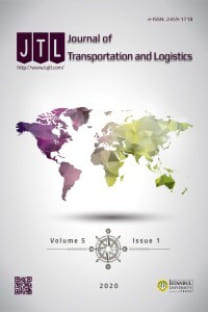Measuring Digital Divide in E-Commerce by Log-Linear Models and Non-Parametric Tests: An Application of Turkey
___
- Agresti, A., (1996). An Introduction to Categorical Data Analysis, John Wiley & Sons,Inc, USA.
- Agresti, A., (2002). Categorical data analysis, second edition, John Wiley & Sons,Inc, USA.
- Arıcıgil Çilan, Ç., (2009). Sosyal bilimlerde kategorik verilerle ilişki analizi, Pegem Akademi, Ankara.
- Canpolat, Önder, (2001). E-Ticaret ve Türkiye’deki gelişmeler, T.C. Sanayi ve Ticaret Bakanlığı Hukuk Müşavirliği.
- Kalaycı, C. (2013). Dijital bölünme, dijital yoksulluk ve uluslararası ticaret. Atatürk Üniversitesi İktisadi ve İdari Bilimler Dergisi,27(3), 145-162.
- Kılıç, Ç. (2011). Küreselleşen dünyada dijital bölünme sorunu. Erzincan Eğitim Fakültesi Dergisi, 13(1), 81-91
- Donna L. Hoffman, Thomas P. Novak, (1998). Bridging the Racial Divide on the Internet. Science, 280(5362), 390-391.
- Eric Tsetsi & Stephen A. Rains, (2017). Smartphone internet access and use: Extending the digital divide and usage gap. Mobile Media & Communication,5(3), 239–255
- Hargittai, E. (2003). The Digital Divide and What to Do about it?, New Economy Hand Book, Chapter 35, Elsevier Science USA.
- Keniston, K., & Kumar, D. (2003). The four digital divides, In Press at Sage Publishers
- Jan A.G.M. van Dijk, (2006). Digital divide research, achievements and shortcomings, Poetics, 34(4-5), 221–235.
- Marı ́a Rosalı ́a Vicente Cuervo & Ana Jesu ́s Lo ́pez Mene ́ndez (2006). A multivariate framework for the analysis of the digital divide: evidence for the european union-15. Information & Management, 43(6), 756-766.
- Menzie D. Chinn Robert W. Fairlie, (2007). The determinants of the global digital divide: a cross-country analysis of computer and internet penetration. Oxford Economic Papers,59(1) 16-44.
- Dragulanescu, N. G. (2002). Social impact of the “Digital Divide” in a Central–Eastern European country. The International Information & Library Review,34(2), 139-151.
- OECD, (2007) Understanding the Digital Divide, https://www.oecd.org/sti/1888451.pdf, Erişim Tarihi: 11.07.2017, 1-32.
- Ono, H., & Zavodny, M. (2007). Digital inequality: A five country comparison using microdata. Social Science Research, 36(3), 1135-1155.
- Brandtzæg, P. B., Heim, J., & Karahasanović, A. (2011). Understanding the new digital divide—A typology of Internet users in Europe. International journal of human-computer studies, 69(3), 123-138.
- Cohendet, P. (2003). The digital divide in the European enlarged economic scenario: an assessment of the socio-economic effects. Strasbourg: University Louis Pasteur.
- Friemel, T. N. (2014) The digital divide has grown old: Determinants of a digital divide among seniors. New Media & Society, 18(2), 313-331.
- Kennedy, T., Wellman, B., & Klement, K. (2003). Gendering the digital divide. IT & society,1(5), 72-9
- Yayın Aralığı: 2
- Başlangıç: 2015
- Yayıncı: İstanbul Üniversitesi
Airport Competitiveness Analysis from Aircraft and PassengerMovement
Fernanda Henriqueta Sabina de MOURA, Mauro CAETANO, Maico Roris SEVERİNO
Maico Roris SEVERİNO, Fernanda Henriqueta SABİNA DE MOURA, Mauro CAETANO
Settlement of Railway Track on Reinforced BallastOverlain by Clayey
Mohammed Y. FATTAH, Mahmoud R. M. AL-QAİSSİ, Mohammed F. ASWAD
Gemilerde Kullanılan Alternatif Yakıtların İşletme Maliyetleri ve Çevresel Etkilerinin İncelenmes
Mohammed Y. FATTAH, Mahmoud R. M. AL-QAİSSİ, Mohammed F. ASWAD
Gemilerde Kullanılan Alternatif Yakıtların İşletme Maliyetleri ve Çevresel Etkilerinin İncelenmesi
Sultan KUZU YILDIRIM, Çiğdem ARICIGİL ÇİLAN
